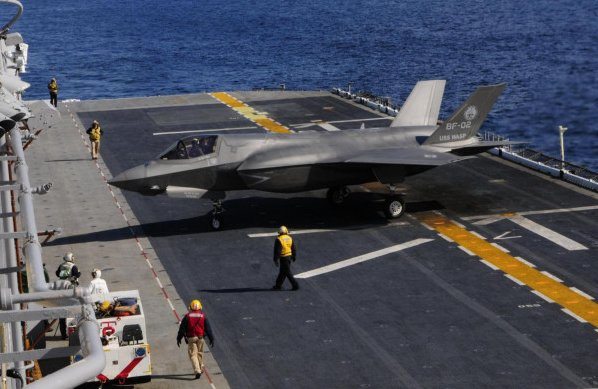by Winslow Wheeler, director of CDI’s Strauss Military Project
Last week, on October 13, the Chairman of the JCS, General Martin Dempsey, scared F-35 advocates with the statement, “I am concerned about the three variants, whether as we go forward in this fiscal environment, whether we can afford all three.”
This week (after a senior official’s visit on Saturday to the USS Wasp, where the F-35B has been conducting “sea trials,” and where a decision was made to gin up a “media day” to booster the F-35), the Marines invited a gaggle of reporters out to the Wasp to show them how wonderfully well the F-35B was doing in its sea trials. Several media writers dutifully wrote about what they were shown and told—and little else. In fact, what they wrote would have you think the F-35B’s problems are all a thing of the past.
Given the Marines’ painfully obvious anxiousness to promote the F-35B (and the interesting timing of their show-and-tell right after General Demsey’s statement), it is especially depressing that no one went out to the Wasp loaded for journalistic bear. Nor was there any apparent follow up when they got back with questions to Joint Program Office head Admiral David Venlet or the top Marine Corps F-35 advocate Commandant James Amos.
Here are some issues that I am told the media writers missed:
- Apparently, the two F-35Bs involved in the sea trials had been diverted to Patuxent River to be repaired the previous week—presumably for fixes the crew on the Wasp were unable to perform. One of the aircraft flying the displays for the press, BF-4, broke (again) after the media event. The upper lift fan door actuator—a component that was supposed to have been fixed already—apparently had a problem. It turns out the actuator has to be redesigned yet again.
- When asked about maintenance on the Wasp, officials speaking on behalf of the F-35 did not say that more maintenance had been taking place than had been planned. It is not clear if that does or does not mean the extra maintenance that took place at Patuxent River.
- Despite at least one media writer’s descriptions of impressive landing parameters during the displays, I am informed that the effects of the Wasp’s structure were causing the ship to slow down because the handling qualities resulting from the wind coming around that structure were not what they expected.
- The testing was planned for a two week period, but it ran on into a third week. It would be interesting to know if there was anything beyond the extra maintenance that explains this.
There also appear to be some issues with the Air Force’s “A” model:
- It appears that the four Lot 2 F-35As at Eglin AFB are effectively grounded. The USAF airworthiness authorities haven’t given the program the flight clearance to start flying the jets. The jets may have been cleared for ferry from the plant in July and August but not for training operations at Eglin.
There has been pressure to clear the aircraft for training operations notwithstanding the following:
- The ejection seat and pilot escape system in the jets have not passed the required qualification tests. This is a particularly interesting because one media writer just reported on how the Air Force’s Air Combat Command is considering a change in the manufacturer for the ejection seat, but the explanation is that it is for cost reasons. It is asserted that a change at this late stage would save money, but how is unclear and appears, at least to me, controversial.
- There are problems with being able to restart the engine in flight if it flames out.
- Braking on a wet runway is deficient—recently improved but not resolved; so jets will be restricted from flying after it rains until the runway dries out.
- The airplane in the training configuration has about 70 hours on it. If you count all JSF testing, it is about 1,000 hours. Legacy aircraft training would start with at least twice that much on the fleet, and as much as five times that much in the configuration meant for training.
- All of this also applies to the Marines F-35B that is supposed to start flying at Eglin in January.
Finally, I am told the cost to modify jets in lots 2-5 is about $30 million each. Lockheed has said these costs are already accounted for in the program. Specifically how this will be paid for, the impact on deliveries, and the size of the fleet that is funded are all questions that are unclear to me.










